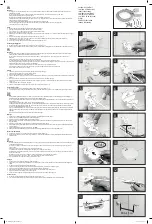
Graham Architectural Products
Homeowner’s Manual
Acoustical Aluminum Windows
5
Table I. Maximum Humidity Levels for No Window Condensation
(Interior Glass Surface
1
)
Glass Surface Temperatures and Relative Humidity with Inside Temperature at 70°F
Single Glazed Window
Double Glazed Window
15 mph wind
No wind
15 mph wind
No wind
Outdoor
Temp.
Indoor Glass
Temp.
Indoor R.H.
Indoor
Glass Temp.
Indoor R.H.
Indoor
Glass Temp.
Indoor R.H.
Indoor
Glass Temp.
Indoor R.H.
40°F 47°F 44% 55°F 59% 59°F 68% 61°F 73%
20°F 32°F 24% 45°F 41% 52°F 53% 56°F 61%
0°F 17°F 12% 35°F 27% 45°F 41% 50°F 49%
-20°F 2°F 6% 24°F 17% 38°F 32% 44°F 39%
-40°F
-14°F 2% 14°F 10% 31°F 23% 38°F 31%
1
There are many different types of window framing materials. These values are for the window glazed area only.
Recommended maximum humidity levels to prevent condensation on all parts of the window are listed
below taking into account various window framing materials and glazing types. These are the
recommended humidity levels, and may not be applicable for every household. Differences in glass types
(lowE vs. clear) will allow for variances in humidity levels.
Outdoor Temp. Maximum Indoor Humidity with 70ºF Room Temperature
+10ºF to +35ºF
not over 35%
0ºF to +10ºF
not over 30%
-10ºF to 0ºF
not over 25%
-20ºF to -10ºF
not over 20%
-20ºF or below
not over 15%
Other factors that influence condensation are:
Window Size-
Larger windows may have a higher tendency to show condensation.
.
Window Location-
Windows protected from the wind will have a higher tendency to show condensation.
Screens-
Windows protected by exterior screens may have a different condensation behavior than the
same windows without screens under the same conditions.
Air Circulation
- Good air circulation, such as exposure to wind, reduces the occurrence of condensation.
Building projections, foliage, and other wind breaks may contribute to condensation.
Interior Shades-
Opening interior shades or blinds may reduce condensation by allowing more heat to
transfer to the outside or allow interior room airflow to come in contact with the window.
Minor differences in conditions can cause condensation to form on one window and not on another, even
when they are side-by-side. Finally, condensation on windows can be a seasonal, night-time event. When
outside temperatures are warm, the glass temperature will usually be above the dew point. The same is
true during cold, winter weather. Condensation will most often occur during transition months.







































